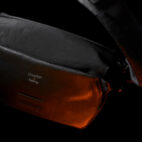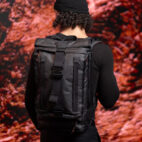
General

We'd like to welcome new contributor, Jon Custis. Jon is a retired infantryman, currently serving diplomat, and professional nomad. His thoughts on carry are influenced by years of suffering under packs stitched up by the lowest bidder; he joined Carryology to shed those scars.
Necessity is indeed the mother of invention, and when smart people have specific needs, they create unique solutions.
Third Block Gear is the systems solution branch of Third Block Group, the brainchild of Jason Rexilius, veteran U.S. Air Force intelligence analyst and persistent creative thinker. He developed the company to provide open-source intelligence assessments, mapping surveys and other technical services solutions in conflict and disaster environments.
The latest offering from Third Block Gear is the Advanced Field Sling (AFS) Bag, originally produced in 2018 for private clients and now available for public pre-order. The sling is produced in limited batches at the moment, but increased demand could change future production planning.

The AFS is the current evolution of a carry solution which Jason and his partners have been refining since 2011, when he conducted an observer mission to Mogadishu, Somalia as a consultant to the UN-recognized federal government. That mission spawned the original “Observer System”, creating a wearable suite of tools and devices used for collecting and sharing information in the field.
Jason went into Somalia with a plan to keep sustainment gear in a safe house while carrying mission-essential and “oh-shit” gear with him in a backpack. The constant movement in and out of vehicles, as well as the need to maintain up-to-date position location, exacerbated that backpack’s shortfalls and once he returned he sought a better solution for his needs.
“Being constantly on the move, in and out of vehicles, walking through crowded areas, and needing quick access to your gear make the backpack form factor far less than ideal.”
Follow-on deployments to Iraq and the Philippines validated his design concepts and the final refinements are now available in the AFS, which is stitched up in the USA by First Spear with 100% Berry Amendment-compliant materials. Jason designed the AFS to be ambidextrous, lightweight, accessible from a number of positions (e.g. seated in wheeled transport) and capable of carrying a mission-essential level of equipment and food/water.
I reached out to Jason and acquired a sample of the AFS for test and evaluation across a few months and several trips. The unit he provided was returned at the close of the evaluation, in order to continue to serve as a test bed for future technology developments.

Specifications
- Name: Advanced Field Sling Bag
- Brand: Third Block Gear
- Format: Sling
- Measurement: 13″ high, 10.5″ wide, 5″ deep
- Capacity: Around 10L
- Weight: Just under 2 lbs.
- Zippers: YKK
- Material: 1000D Cordura
- PriceUS$395
Who It Suits
Light trekkers, humanitarians, war correspondents, close protection personnel, law enforcement professionals and search-and-rescue teams.
Who It Doesn't
Urbanites in need of intricate organization, backcountry thru-hikers or the fashion-conscious in need of a formal look.

Materials
An ITW GT quick-release Cobra buckle is a key component of the AFS and is located at a very logical position on the strap. I found it very easy to activate the buckle with a natural motion when practicing emergency doffing of the bag.


The body of the strap is constructed of breathable mesh and the same material lines the full face of the sling’s back. I did not experience any issues and cannot see it posing an abrasion problem for a user’s clothing.

Two Tweave 520E DURASTRETCH side pockets are versatile enough to accommodate 1L Nalgene bottles, personal radios or individual first-aid kits. Bungee-cord attachment tabs allow for the addition of adjustable lengths of cord as additional retention. The pockets easily held locally-sourced 1.5-liter water bottles, a 20 oz. Hydro Flask and various run-of-the-mill thermoses during my evaluation.

The main compartment is fabricated with 1000D Cordura and flanked by two one-way YKK side zippers that run the length of the bag and close upwards to prevent items from tumbling out. The inside is lined with loop-Velcro that allows for user customization with any hook-Velcro pocket or organization panel, but since it is a side-access space, unlined pouches are a better choice.

An outer pocket constructed of Hypalon is lined with loop-Velcro on one side, and as it doesn’t have its own volume, was designed for small, thin items like rubber gloves, hygiene items or a power bar. It is perforated and laced with approximately one meter of bungee cord that can be used to secure a solar panel in its deployed position or hold a light jacket. Jason has experimented with mock-ups of black, blue, and red Hypalon to form the outer pocket area, so those colors might find their way into future production runs.
This Hypalon extends to the bottom of the AFS, where other notches and perforations allow for a tourniquet or similar item to be rigged in place. It is also here where a third compartment—Jason refers to it as the “kangaroo” pouch—opens via dual zippers to expose a lined compartment capable of holding a Velcro-backed holster or magazine pouch.

A stowable stabilizing strap tucks away when not in use and although I never had the occasion to use it extensively, it locks the AFS to the body and prevents sway. It has its own quick–release Cobra buckle and if you find yourself in an emergency situation and need to get the bag off your body, you can do so quickly.


Space and Access
Overall dimensions of the AFS are 13″ high, 10.5″ wide and 5″ deep. Because the AFS has a teardrop profile, estimated volume is 10 liters. Empty weight is just under two pounds. The key points to note are the 10″ x 5″ main compartment space and the top-loading rear slot which can accommodate a range of tablets, laptops up to 13″ or collapsible solar panels. I did not have one on hand to verify, but it appears that a 1L hydration bladder could be squeezed in there if you need to use the side pockets for other gear.

In keeping with its original role as a carry item for field missions, the main compartment is capable of holding a surveillance tool like the Yuneec Mantis Q foldable drone or team-level biometric enrollment/verification devices and trauma care items.
There is no internal organization for smaller items because that is built into the strap itself, in the form of a small admin pouch (notebook and ID card pockets), GPS sleeve and smartphone compartment (sized for up to 3.25″ x 6.25″ phones). Loops of bungee cord and Velcro-backed strips provide additional retention to the elasticized material that forms these spaces.

During a recent trip to Cairo, the AFS allowed me to comfortably carry a Nikon mirrored DSLR, six passports, individual trauma kit, iPad (6th Gen), cables pouch, 1.5L water bottle, Clif bars, two iPhones, base layer and various documents and small maps for the duration of each day, without the back sweat guaranteed to come with a standard backpack.


When the main compartment is maxed out, only the rear slot has its own volume, so it does require attention when using the front or kangaroo pockets. It does not have a frame sheet and can be folded/rolled up when empty.
The Good
The AFS has several thoughtful elements built in, like a writing instrument slot and a mini dump pouch tethered to the strap. Although it does not ship as standard with the AFS, any three-foot USB power cord can be woven through the strap, connecting a power bank or solar panel in the rear slot to a phone stowed in the compartment above the buckle.

This is not a dainty sling bag. It has substance and a sort of natural balance that works well, even when the side pockets are loaded down with water or critical gear. It rotates forward easily to allow access to the compartments and I was able to drive with it in my lap. This was a critical element of the original design, as Jason wanted the sling and any electronic devices to be operational as soon as the wearer dismounted a vehicle.


The smartphone compartment’s orientation also allows discreet video recording of surroundings and subjects in front of the wearer during foot movement. I wish I had that capability during dozens of key leader engagements and short foot patrols while deployed to Iraq and Afghanistan.
Not So Good
The AFS comes with only a thin strip of Velcro for extra retention on that compartment and I would rather see it replaced with something more robust, for peace of mind.
The adjustment straps seem unnecessarily long. Although the user could always customize their length by simply trimming a few inches and burning the ends, some sort of oversized web dominator would have been nice.

Verdict
The price on the AFS is going to raise a few eyebrows, but the materials and craftsmanship warrant the cost. And remember, the initial market for the AFS was focused on government customers, so a “Made in the USA” standard is the norm.

For certain niche users, Third Block Gear’s Advanced Field Sling is the sort of carry solution they’ve always known they needed, yet could not find and purchase. They therefore developed workarounds or half-solutions which never fully met their requirements. For those folks, the search is over.






 Carry Awards
Carry Awards Insights
Insights Liking
Liking Projects
Projects Interviews
Interviews









